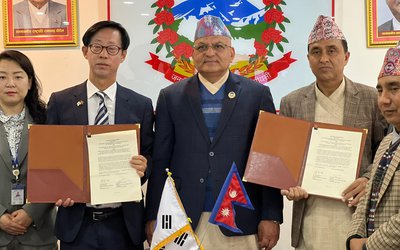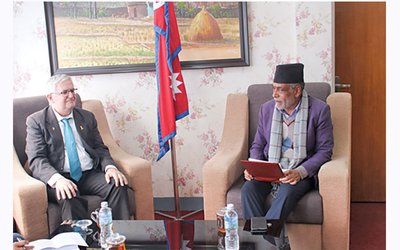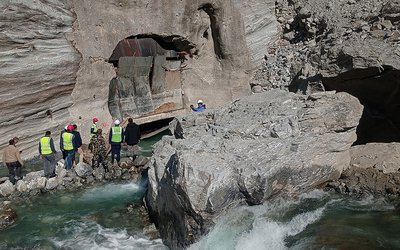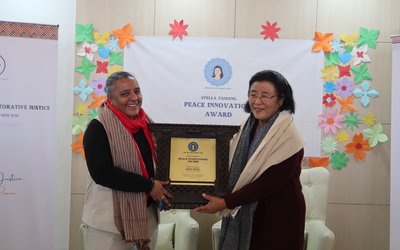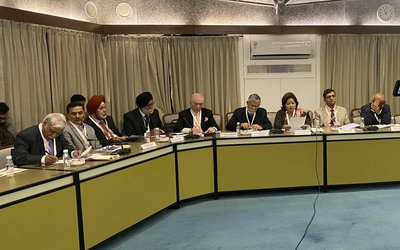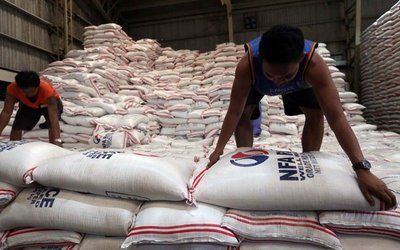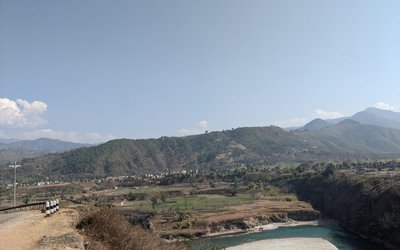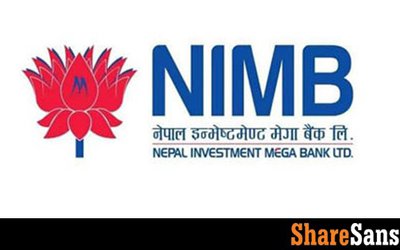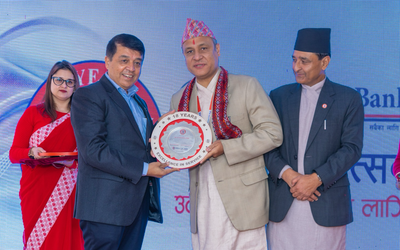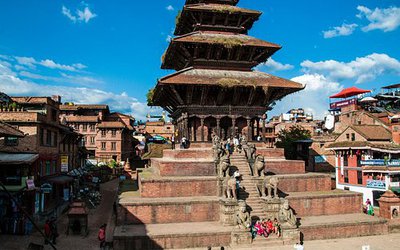
Tribeni River Concern Group
The Tribeni River Concern Group (TRCG), a loose forum of professionals representing diverse backgrounds is passionate to protect rivers and to explore the significances of rivers in terms of socio, cultural, customary, spiritual and religious aspects. It is also keen to learn about hydro-ecological impact and biodiversity through research and policy analysis.
It is estimated that Nepal has more than 6,000 rivers and rivulets, and over3000 glaciers. These are the major sources of freshwater that satiate the thirst of the Nepalese population. River water bears religious and cultural significance in Nepali societies. Due to its social norms and values, and customary system, an individual cannot pollute, encroach and destroy the water body since itis considered a sinful act. As these values and ethos have been waning in recent times, the TRCG attempted to assess what is ailing our pristine, religiously and culturally rich rivers and suggests some doable measures to restore its lost luster. In light of the above objectives, the TCG had carried out a rapid investigative survey on the situation of the community’s behavior that caused the river pollution. The team studied human activities along the Naubise to Devghaton the highway that has been polluting Trishuli River. A three-day assessment visit was carried out towards the end of January 2020 in which the major place of settlements was observed, held discussion with locals and captured some places of an unattended pile of garbage along the river and discharge of harmful waste to the river.
History of Trishuli River
The legendary story tells that the Trishuli is named after the Trishula or trident of God Shiva, the most powerful who drove his trident (Trisul: Iron or copper) into the mountain to create three springs to get rid of from the Kalkut (the deadliest)poison.

The Trishuli River originates from Tibet and crosses the Nepalese border with Kyirong gorge and thereafter, it flows through Nepal and meets several rivers and rivulets on the way to Devgahatlater known as the Narayani River. The major rivers of Narayani are Trishuli, Budi Gandaki, Marshyangdi, Madi, Darudi, Seti and Kaligandaki and it is also known as Sapatagandaki (7 rivers). All these rivers bear some sort of religious values; people take bath, sprinkle river water over their bodies to purify, and worship them on different occasions for religious and cultural merits. Among them, Devghat, a confluence of Narayani and Kaligandaki is the major one. AtMagheysankarinti (around Jan 15) thousands of people from Nepal and India visit the place and pay religious tributes. TheDevghat is also considered as a sacred religious place where people often visit to perform several religious rituals such as Sradha, Bratbandha and some puja with a votive offering, etc. It also has a cremation site for Hindus on the bank of the river.
Investigative Method
A three-day study kicked off on 31st January 2020 and concluded on 2nd February. Within the duration, the TRCG team visited different places and observed the situation in a comprehensive manner. They had discussions with locals, hoteliers, traders, resorts managers, religious groups and commuters to know why and how the rivers have been so polluted and what has been done by the concerned authority to protect its serenity. During the trip, almost a half dozen sites along with the condition of the river were observed and snapped photos about inhuman activities to know the situation.
Despite having so many religious and cultural values, these rivers were haphazardly polluted by the human settlements especially after the roads were built. The TRCG members investigated the cultural and religious aspects of the river and how the river is turning into an eyesore as a result of unethical and immoral human activities. There were different inventories spotted, observed and discussed with local, business personnel, hoteliers, restaurants and resort owners as a key informant to elicit their response. The response focused on the societal behaviors, practices-based traditions, opportunities and challenges, local governmental law regarding garbage dumping, wastes, seepages, pollution and river encroachment.

River-Bank encroachment for sand quarry.
An observation survey was done by the team from Naubise to Devghat along the Trishuli River that flows southwest and meets several other rivers along the way which is later known as Narayani River. The main hypothesis was the human settlement and domestic animal wastes are directly discharged into the Trisuli River up to Mugling, and thereof, Narayani River to Devgahat through open drainage which badly polluted the river water and its natural aquatic ecosystem since most of the places have no separate drainage systems-built to manage the sewerage and waste management. This was the first initiative of the team to learn, understand and advocate for reducing river water pollution in the days to come. Some empirical evidence were prioritized more than secondary information analysis.
Discussions and Results
Ever-increasing unorganized and unplanned stops, hotels and restaurants along the Kathmandu Pokhara (Pritivi-Rajmarg) Highway and rivers are inextricably related to each other. The hotels along the highway create job and business opportunities for locals providing services to travelers. In simple words, they are the source of livelihoods for many livings along the highway. Moreover, they help in generating local revenue which is essential to reinvigorate the local and also the national economy. But the unmanaged and unregulated waste discharges from the settlements are far-reaching consequences in rivers that cannot be overlooked. No regulatory body on preventing the river water pollution so far has been found. The local community in someplace along the riverbank found little awareness of the pollution damaging the environment and, in some place, they turned completely a blind eye on it.
It is axiomatic that a clean river fosters the socio-economic and cultural aspects of people living along the river. However, in order to keep these rivers and rivulets clean, active and vibrant, an enabling and protective environment must be created for maintaining our rivers sanctity. Actions and activities of humans that ruined our pristine rivers and their branches should, therefore, not be encouraged at all. But today, there has been widespread concern over the growing jeopardy and assault on our pristine rivers owing to growing unethical and inhuman actions. This is more on the highway where the fears and concerns have been expressed, of late, from several quarters with regard to not so encouraging or satisfying the fate of our rivers.
The Trishuli River is one of the most historical, environmentally important, religiously and culturally considered sacred rivers in Nepali societies. It is considered as a lifeline for many people living along with in helping many aspects of irrigation to the source of drinking water, maintaining life of fisherfolk, raising goat, piggery and poultry, and promoting small-scale businesses. Also, the river bank’s natural ecosystems are very essential habitats for water and other terrestrial birds and biodiversity. However, the situation has changed drastically as a result of heavy encroachment of river belts and inhuman activities.
These settlements have emerged over the years as small townships with small hotels, restaurants and shops when the highway and its feeder roads opened. Rivers and small streams from hills and mountains are connected to these rivers which make often act as a carrier of human settlements waste. An eyewitness said it is not so long ago, these rivers were crystal-cleaned and people used its water for bathing, drinking, household activities, livestock raising, and worshiping since the river is considered holy in Nepal. There is a belief that one needs to be purified bodily and clean spiritual pollution i.e. cleaning bad karma of the past by taking a dip-bath into the water and worshiping to these rivers.

Sewerage into the Trishuli River
The above photograph illustrates the leakage of sewage into the Trishuli River. The sewage that includes harmful chemicals is being drained to Trishuli endangering the aquatic animals and adversely affected the locals who depend on the river for their survival. When asked about what led such unregulated drained sewage into the river, a local said “we know it is the easiest way to manage our waste but we are compelled to do this since there is no alternative left”. It is high time to think about other alternatives to manage their waste as the river is turning into the bed of solid and non-decomposable and imperishable waste threatening the lives of aquatic culture.
As the human settlement has increased multi-folds along the highway; the waste generated by them has also maximized exponentially. The waste such as plastics bags, papers, plastic and glass bottles, and other wastage are dumped in piles which remained unattended for several days or even months. What is very worrisome is that these wastes during the rainy season turned into nasty producing pungent smell and breeding ground for water-borne diseases in and around the areas.
Spots Observed
- Galchhi is an emerging township in the Dhadingdistrict named after Galchhi River. Predominantly a Tamang Community, the Galchi has been rapidly turning into a small commercial hub that showcases the agricultural and other products from local and adjoining districts. The numbers of hotels, tea stalls, resorts and restaurants have been emerging to cater to the needs of local and passerby.
Of course, the area is fast converting into a small economic zone, the catastrophe it has invited in terms of environment cannot and should not be overlooked. The “development comes along with destruction” goes the saying. This time-tested adage seems to be true in the context of the Galchi and its surrounding areas. The growing unregulated hotels and restaurants and the waste generated by them, caused the river pollution making the areas almost inhabitable. Most of the toilets were made behind the shops, and restaurants facing the rivers. The sewerage can be seen flowing the river through necked eyes. To the utter dismay, no safety-tanks were built to deposit human waste raising the ground for triggering the waterborne disease. It was irritating to see kitchen drainage, bathing and washing water being drained to the river Galchhi which meets Trushuli River in a few meters away.
The team was also saddened seeing the littered Galchhi River with waste generated by local people and travelers who halt there for refreshing. The passengers throw the plastics and other indecomposable waste haphazardly which was seemed draining into the river raising the eyebrows of the visiting team. Though people are mindful of the growing pollution of the river, no serious steps were taken into consideration to deal with it. As a matter of fact, a local said that everyone is throwing garbage and human wastage to the river contributing to the tragic scenario of the river. If the local authorities continue to turn their blind eye onto the problem, the settlement is likely to witness a danger posing threat to humanity in the areas in the future.
- Sitalegaonpalika (ward No -2, Malekhu) is situated in Kathmandu-Pokhara highway, in Dhading district. The areas have been drawing the attention of travelers and passersby as it is gradually turning into a major place of attraction in terms of economic activities. Both sides of the road are occupied by human settlements; shops, small food-stops and restaurants are coming up to serve the travelers. As human settlements have increased in the areas, the waste of plastics and water bottles as a result of human activities have also increased which are eventually drained into the river. While some local initiatives including a locally-led committee have been formed to manage the waste, it has not been able to bear the fruit as desired. Likewise, to mitigate the problem, two separate safety-tanks have been installed at each house of the community. One stores the solid waste while other stores the liquid waste which comes from the kitchen, bathroom and toilets. The tank is cleaned when deemed necessary. Once the tank is cleaned, it functions for more than a decade. A single cleaning of a tank charges up to NRs 8000, said a local hotelier.
While sharing his views on how safety tanks operate, a local hotelier who is also the secretary of the drinking water management committee in the localities told us that no one is allowed to link directly the drainage of one’s home to the river. If someone is found neglecting the provision, a penalty of NRs 500 is slapped. This was something encouraging initiative by the local toward preventing river water pollution.
- Mugling Bazar came into being after Prithivi-Rajmarg(highway) was opened and started functioning. The Mugling Bazaar, at times, was very famous among the travelers as it was considered a transit point for many people traveling Kathmandu-Pokhra- Narayanghat. In a short span of time, the Mugling turned into a commercial hub and offered jobs for local youths. The Bazaar houses over 100 hotels and restaurants which provide employment to locals’ primarily male youth.
Despite growing human settlement and human activities, the river flowing along the village was little affected by the waste released by hotels. This can be attributed to the construction of a reserve tank to manage the waste. However, the visiting team witnessed dumped garbage below the Mugling Bridge which eventually drained to Narayani where Trishuli and Marshyangdi meet.
While assessing the Mugling Bazar, the areas lying nearby the Mugling Bridge over the Trishuli River drew our attention. There was a huge unattended dumping pile of plastic garbage contributing to polluting the wetland ecosystem. This was something not accepted given the safety tank being installed at each household to reduce the assault on the river.
In Mugling Bazar, the team observed the drainage constructed on both sides of road. It was found that the waste was thrown haphazardly though there was a tank to manage the waste in each household. The tragedy is attributed to the growing disregard of laws and lack of awareness among the people. It was a bit surprising to witness such a pile of garbage right under the nose of Police Check Post. More worrisome was that the wrongdoers walk free without fear of being nabbed and prosecuted.

Collected garbage back of a restaurant at Mugling.
- Aabukhairani: on the margins of the Mugling Bazar assessment, the team also visited Abu Khairani, a small emerging township where the road joins to the Gorkha district. Due to the Marshyangdi hydropower dam, the water has been diverted to the hydro-turbine and the river wears a deserted look as the water flowing down the river has been diverted and used for hydroelectricity. Had there been some legislation that says at least 10 to 15% water need to be released to the river for aquatic survival, the situation would have been much better.
However, the small local township at Ambukhairani offered us a surprise. It was very clean, thanks to the high awareness level of the locals. The municipal sponsored two dustbins are placed in front of each shop and hotel with a bid to keep the surrounding clean. One was for decomposable waste and the other was for non-decomposable waste. Among the areas visited, this place was found simpler and cleaner. When asked about the management of collected waste, the locals said that the garbage collectors visit the area twice a week and take away the waste to the landfill site.
- Mugling to Narayanaghat highway has been widened recently along with Narayani River which flows southwards. The widened road provides hassles free journey which was unthinkable until a few years ago. After traveling almost 15 km towards Narayanghat, the team spotted 2 to 3 local restaurants. It was found that hoteliers had built toilets for the passers-by, and a separate clean water pipe was running without any limitation. The areas were clean and well managed. The healthier and pollution-free environment can be attributed to the growing awareness among the locals.
Unlike Mugling to Naubise, the river was seen cleaner here since the toilets were constructed and maintained contributing a better environment. They have built two separate safety tanks; one for solid waste and the other for wastewater (washing-water). According to the local, it takes around 15 to 20 years to fill the safety tanks.
- The Devghat- a confluence of Narayani and Kaligandaki, is considered a religious holy place where thousands of people from India and Nepal visit for religious merit. They dip into the rivers-confluence to purify themselves. There are several Ashrams and dozens of temples where sages and some common people (pilgrims) stay for religious purposes. While being there, one can feel very peaceful seeing tranquility of the confluence, mountains and greenery around.

People pay tribute to the river.
While returning to Kathmandu, the team again tried to investigate some areas which the team missed. In Malinga-3, a huge pile of garbage of the Benighat Rural Municipality was seen that drew our attention. The garbage that was lying unattended had become an eyesore to the commuters and locals. But nothing serious was done in this regard. And it was reasons to worry as the wastewater drained to river rampantly. Though a locally-led committee had been formed to resolve the problem,it has been ineffective as perceived.
The situation was the same in Naubise of Dhunbesi Municipality of Dhadingdistrict. Despite being an adjacent district to the Chandragiri Municipality of the country’s capital, some areas of Dhunbesi Municipality such as Naubise was found to be seriously affected by the unmanaged and uncontrolled waste that eventually was drained into the river. The local shared that the municipality has not taken the problem seriously.
It has been found that the river has been badly polluted when we approach towards Kathmandu. In a nutshell, closer to the capital, the dirtier the river.
Conclusion And Finding
On the basis of observation, discussion with local and photo analysis, it came to the conclusion that the dirtier the river, closer the country capital. Being nearer to the capital city, we thought people must be mindful of the cleanliness but the case was found just opposite. Indeed, the farther the team moved from Kathmandu; the cleaner settlements found. No pollution control plant has been installed so far along the highway.
- The awareness level of people in the visited areas found to be little high against prior perception to visit
- Locals have, in many places had installed safety tanks for the effective and proper management of the waste generated from their activities but not in all places.
- People are more concerned about their local environment to keep clean for living a healthy life and maintain their sacredness but initiatives need yet to take seriously.
- People's felt rivers should be kept clean adequately and effectively but due to lack of support from the government, they are not able to manage waste properly.
- The social, cultural, religious tradition and values of Nepalese societies should be respected and promoted towards protecting the cleanness of rivers with its natural flow.
Recommendations
- A multi-stakeholder initiation including the government, non-government, private business sectors and local people(Federal, provincial and local governments including, NGOs, INGOs, political parties etc.)should take serious steps to prevent the river from getting further polluted
- The ongoing land encroachment of river-belt is also a major concern. The government should take a radical step to stop ongoing encroachment of land along the river’s sides in partnership with locals. If this is not stopped now, these rivers will remain no more rivers but wastewater drainages. The impact will be heavy and people have to pay the heavy environmental prices later. An immediate action to prevent river pollution urgently required.
- The team also likes to recommend establish a local waste management committee at least in each settlement. A bill should be passed by the parliament and bring it to enforce to save and maintain the original shape of these rivers. Otherwise, it will destroy our environment and eliminate humans and aquatic lives.
- A further in-depth research study needs to be conducted to prepare an action-strategy to prevent river water pollution.

People enjoying boating at Devghat
For Detail Contact: Gyan BahadurAdhikari, Team Leader, Tribeni River Concern Group (TRCG) Email: riverconcern2020@gmail.com E-mail: riverconcern2020@gmail.com

